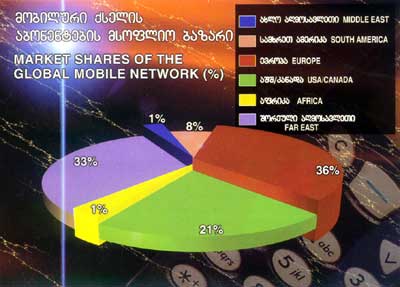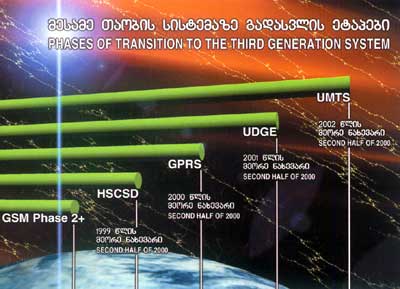

Only two decades have passed since mobile phones first appeared but already mobile communications have undergone significant changes. The first generation systems, based on the analog cellular principle, were used exclusively for voice transmission. The second generation mobile systems, including GSM standard, improved transmission quality and signal protection, provided low speed data transmission, and for GSM systems - an automatic roaming service covering countries and continents.
Soon after the introduction of the second generation digital mobile phones, preparations began to design the next generation mobile communication standards. With this in mind, the ITU (International Telecommunications Union) set up an initiative group in 1985 which was renamed IMT-2000 in 1996, with ‘2000’ standing for both the technology of the new millennium and the new frequency range allocated for that technology - 2 GHz.
The third generation (3G) technology provides high speed voice and image transmission (the speed will supposedly be 2 Mbps instead of the 9.6 Kbps available today), multimedia and Internet service and data exchange between the mobile phone and the computer/Internet. At the same time 3G technology will improve the service quality of the second generation networks by adding a number of new services.

Experts consider there will be no common standard for the third generation technology handsets at the initial stage. Great efforts have been made to create a common system for operators worldwide but with little success. According to preliminary information, 3G technologies will have at least 3 standards, and the first 3G terminals will use only one of them.
European countries have chosen W-CDMA (WideBand Code Division Multiple Access) interface, developed by the Swedish company Ericsson, to provide switching from GSM to 3G technology.
W-CDMA’s main competitor will be Qualcomm’s cdma2000 technology which will supposedly be used by the Japanese companies currently operating cdmaOne technologies. The Japanese system DoCoMo will be the exception as this system will be developed in association with W-CDMA. For operators using TDMA (Time Division Multiple Access) technology (this mainly refers to North American operators) 3G is known as UWC-136.
3G standard specifications are still in the process of development. The Institute of European Telecommunications Standards is developing a UMTS (Universal Mobile Telecommunications System) standard which complies with the specifications of IMT-2000. Frequency ranges have been allocated for the new UMTS system: 1885-2025 MHz and 2110-2200 MHz for the further development of IMT-2000, where 3G service satellite communication has been assigned 1980-2010 and 2170-2200 MHz paths. However, as the first stage of 3G technology comes to a close, licenses for the operation of UMTS standards have already been issued in some European countries, while in many others applications for such licenses are still under examination. Manufacturing companies and operators do not waste their time and carry out trial launches and equipment testing. As far back as in early 1999, Nortel Networks and BT (British Telecommunications plc) announced they would jointly test 3G/UMTS prototype equipment and terminals in order to better explore 3G systems technology and the future markets. BT and Panasonic alliance is already using mobile phones with built-in video cameras, TV displays and a data transmission speed exceeding 64 Kbps.
The year 2002 is expected to be the launch date for 3G in Europe, although a revision of that date is also possible. Japan, though, intends to introduce 3G technology one year earlier than Europe.

Until transition to UMTS is fully comleted, several stages must be passed, which will, step by step, lead to the full scale introduction of the new system.
Transition Stages to the 3G System
| GSM Phase2+ | GSM Phase 2+
(9.6 Kbps) |
| HSCSD | High Speed Circuit switched data
(38.4 Kbps) |
| GPRS | General Packet Radio System
(114 Kbps) |
| UDGE | Enhanced Data GSM Environment
(560 Kbps) |
| UMTS | Universal Mobile Telephone Service
(2Mbps) |
HSCSD -
High Speed Circuit Switched Data
This technology will allow mobile phone users to receive data by a mobile terminal at a much higher speed than allowed by current GSM network. Transmission speed here will reach 38.4 Kbps, which is almost the same as the data transmission speed offered by a modem for normal fixed phones. HSCSD clears the way for the introduction of a new type of service in the mobile communications market. A huge increase from 9.6 Kbps (standard speed for GSM), HSCSD is the first step towards 3G multimedia services.
GPRS - General Packet Radio System
GPRS is one of the most significant technologies in the transitional period from the second generation systems to UMTS. GPRS is often referred to as GSM-IP (GSM Internet Protocol), since this is the technology offering the GSM subscriber a direct link with an Internet provider at 114 Kbps. Another difference between GPRS and the older generation systems is that GPRS allows the subscriber to have a constant connection with the switch or stay in the so-called On-Line mode. The new system demands a new payment principle: with GPRS the amount you pay depends on the volume of transmitted data instead of airtime usage.
EDGE - Enhanced Data GSM Environment
EDGE is the final stage in the transition to UMTS. It allows GSM operators to offer subscribers a multimedia service at 384 Kbps (maximum speed for GSM technology).
Experts say that GSM operators can introduce EDGE smoothly and at relatively low cost, as it will require no more than slight changes in the operators’ software and hardware. The system will use TDMA (Time Division Multiple Access) interface typical of GSM, and a 200 KHz step range.
It may be difficult to imagine what the new generation mobile phones will look like. Leading manufacturers have already begun developing new phones and 3G handset prototypes, which hardly resemble traditional mobile phones. Such terminals combine voice and video transmission and their test trials are already in progress.
A forecast made by the company ANALYSIS predicts that by the year 2005, 40% of the European population will use mobile phones, and of these, one third will be equipped with the new generation multimedia systems.
According to UMTS experts, the rapid development in this trend in communication will need additional resources in 2005-2010, and they have also named new frequencies - 2.5 GHz or 1GHz - as a precondition for any further technology advancement.
Magti GSM too is preparing for the introduction of these new systems. So we may not have to wait long before the first videophones appear in Tbilisi.
Levan Buchukuri
Head of Magticom Customer Care
and Marketing Department